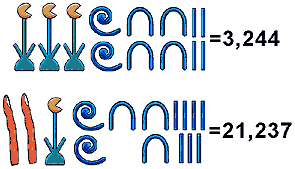Years ago, there were no numerals. No names to define amounts. This is because it simply wasn’t necessary until people began forming villages and such where numbers and numerals were needed as a means of comparison for trading. This in itself is difficult for us to imagine, growing up counting in an Arabic (sometimes known as Hindu Arabic or European) number system, with numerals 1, 2, 3, 4 etc. I should point out that there is a distinct difference between numerals and numbers.
Numerals – symbols we use to denote an amount i.e. when we use “6” , that is a numeral
Numbers – a quantity or measure of amount
Breaking this down further, there are digits. Digits are like the letters of maths – the single digits that make up a numeral. Maths is Fun shows this perfectly (link at bottom of blog):
Numerals are what we use to talk or write about amounts, whereas numbers are the idea that exists in our heads about quantity.
Our Arabic number system developed in India, as the video below shows:
Most languages today use these numerals, however, this was not always the case. The first number system was the Babylonian system in Mesopotamia, using not a base 10 system, but a base 60 system (however, there are elements of base 10 as the system uses the symbols in a tens and units format). Many early numerals are more like symbols to us, just as our numerals would be to the Babylonians – it is simply a case of what you know and what you are familiar with.
Even Roman Numerals, which we are more familiar with, are letter/symbol based. There are two theories about the origins of Roman Numerals (link at bottom). The first is based on hand gestures, just as children count on their fingers now (10 fingers = our base 10 system).
For example, 5 = V. The hand gesture is this (similar to a V): 
10 = X. The hand gesture is this (a cross with the thumbs or hands):
The second theory is based on tally marks on tally sticks – a system used long before the Romans, especially by shepherds counting their sheep.
This same site also alludes to earlier number systems such as the Egyptian system. This is similar in ways, with a single line representing “one” however, they used lines for all digits up to “nine”, and pictures beyond these. An example of larger numbers is shown below (both pictures from Discovering Egypt website).
It is clear that there are many other number systems other than our own that have been used throughout history, and even today in Chinese and Japanese languages. I personally have found these fascinating to  look at and I believe children would find this interesting too, looking at the unknown and how it relates to the obvious that we see and use every day. This study into different number systems all looks towards Liping Ma’s relational understanding. I would not teach these systems while children are still learning their first numerals (1, 2, 3 etc) but it would be an interesting activity with older children, showing them why we have the numerals we do, and where they came from. The activity we did this morning, creating our own number system (see my attempt on the right) was a thought provoking one. You grow up only knowing the Arabic numerals, that creating foreign ones is strange and alien. I think children would learn a lot from this type of activity, not just about number systems, but about how numbers are formed, written and constructed. Like I say, this is not an activity for early years children beginning their maths journey, but for children who are comfortable with the numbers they know and can be stretched further.
look at and I believe children would find this interesting too, looking at the unknown and how it relates to the obvious that we see and use every day. This study into different number systems all looks towards Liping Ma’s relational understanding. I would not teach these systems while children are still learning their first numerals (1, 2, 3 etc) but it would be an interesting activity with older children, showing them why we have the numerals we do, and where they came from. The activity we did this morning, creating our own number system (see my attempt on the right) was a thought provoking one. You grow up only knowing the Arabic numerals, that creating foreign ones is strange and alien. I think children would learn a lot from this type of activity, not just about number systems, but about how numbers are formed, written and constructed. Like I say, this is not an activity for early years children beginning their maths journey, but for children who are comfortable with the numbers they know and can be stretched further.
References:
Pierce, R. (2015) ‘Numbers, Numerals and Digits‘. Math Is Fun. Available at: http://www.mathsisfun.com/numbers/numbers-numerals-digits.html (Accessed 3/10/16)
Roman Numerals and Roman Numbers (no date) Available at: http://www.knowtheromans.co.uk/Categories/SubCatagories/RomanNumerals/#VIII (Accessed 3/10/16)






